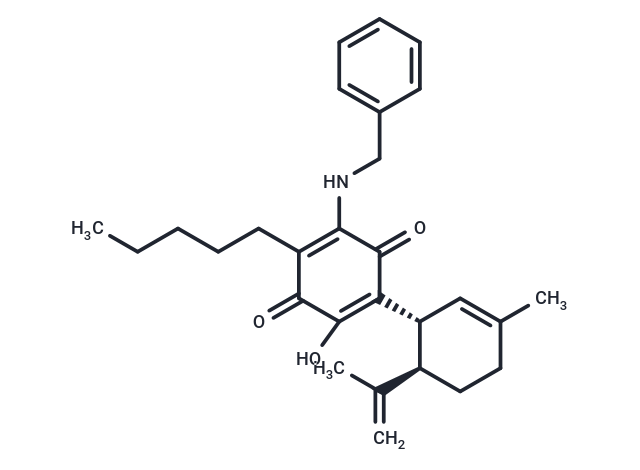Shopping Cart
- Remove All
 Your shopping cart is currently empty
Your shopping cart is currently empty

EHP-101 (VCE-004.8) is a specific dual agonist of PPARγ and CB2 receptor with potent anti-inflammatory activity. EHP-101 attenuates adipogenesis and prevents diet-induced obesity.

| Pack Size | Price | Availability | Quantity |
|---|---|---|---|
| 1 mg | $109 | In Stock | |
| 5 mg | $239 | In Stock | |
| 10 mg | $397 | In Stock | |
| 25 mg | $652 | In Stock | |
| 50 mg | $913 | In Stock | |
| 100 mg | $1,230 | In Stock | |
| 1 mL x 10 mM (in DMSO) | $263 | In Stock |
| Description | EHP-101 (VCE-004.8) is a specific dual agonist of PPARγ and CB2 receptor with potent anti-inflammatory activity. EHP-101 attenuates adipogenesis and prevents diet-induced obesity. |
| In vivo | In HFD mice, VCE-004.8 (injection; 20?mg/kg/day; for 3 weeks) induces a significant reduction in body weight gain, total fat mass, adipocyte volume, and plasma triglycerides levels. VCE-004.8 can also significantly improve glucose tolerance, reduce leptin levels (a sign of obesity) and increase the levels of adiponectin and glucagon (GLP-1 and GIP) [1]. |
| Alias | VCE-004.8 |
| Molecular Weight | 433.58 |
| Formula | C28H35NO3 |
| Cas No. | 1818428-24-8 |
| Smiles | CCCCCC1=C(NCc2ccccc2)C(=O)C([C@@H]2C=C(C)CC[C@H]2C(C)=C)=C(O)C1=O |
| Relative Density. | 1.12 g/cm3 (Predicted) |
| Storage | Powder: -20°C for 3 years | In solvent: -80°C for 1 year | Shipping with blue ice. | |||||||||||||||||||||||||||||||||||
| Solubility Information | DMSO: 49 mg/mL (113.01 mM), Sonication is recommended. | |||||||||||||||||||||||||||||||||||
Solution Preparation Table | ||||||||||||||||||||||||||||||||||||
DMSO
| ||||||||||||||||||||||||||||||||||||

Copyright © 2015-2025 TargetMol Chemicals Inc. All Rights Reserved.